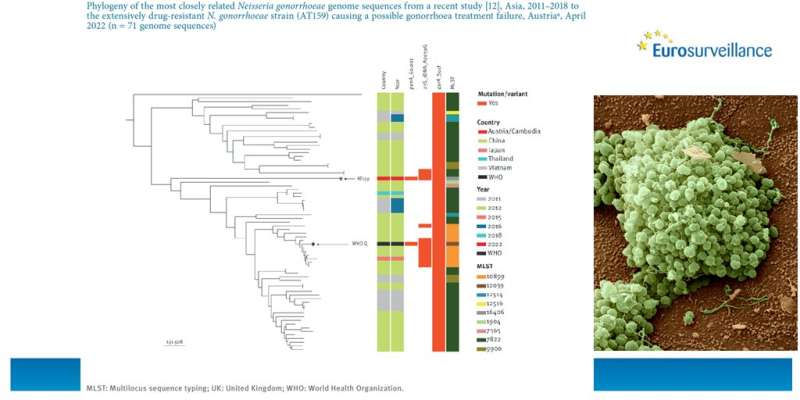New strain of extensively drug-resistant Neisseria gonorrhoeae detected in Austria

Given that there is no vaccine available against gonorrhea, diagnosing this sexually transmitted infection early, treating it effectively and notifying sexual partners are cornerstones of controlling disease spread. However, Neisseria gonorrhoeae has developed resistance to all classes of antimicrobials since the beginning of treatment with them in the 1930s.
As first-line treatment approach, current guidelines recommend either monotherapy with ceftriaxone or a combination of it with azithromycin but resistance or decreased susceptibility to both has been reported worldwide in recent years.
In their rapid communication published in Eurosurveillance, Pleininger et al describe the case of an extensively drug-resistant (XDR) Neisseria gonorrhoeae strain recently identified that shows high-level resistance to azithromycin and resistance to ceftriaxone, cefixime, cefotaxime, ciprofloxacin and tetracycline.
The strain was detected after a heterosexual male patient in Austria presented with symptoms in April 2022 following condomless sex with a female sex worker in Cambodia. The authors note a possible gonorrhea treatment failure with ceftriaxone and azithromycin as no post-treatment gonococcal isolates were available. Following the initial treatment course, the test of cure was negative, but a polymerase chain reaction test from the urethral swab culture sample was positive for Neisseria gonorrhoeae.
XDR gonorrhea challenges current treatment options and recommendations
According to Pleininger at al, the molecular investigation of the isolate establishes the detected strain in Austria as the second global gonococcal strain with ceftriaxone resistance combined with high-level azithromycin resistance and relatively close relationship with the "WHO Q" reference strain. The "WHO Q" strain has been associated with three cases of gonorrhea notified in the United Kingdom and Australia in 2018 with reported links to South East Asia.
Multidrug- and extensively drug-resistant Neisseria gonorrhoeae strains are a global public health concern given the limited remaining treatment options. Establishment of strains as described by Pleininger et al with sustained transmission might make many gonorrhea cases untreatable.
To address this, the authors conclude that "enhanced antimicrobial resistance surveillance (ideally including test of cure and whole-genome sequencing), nationally and internationally, particularly in Asia where many ceftriaxone-resistant strains appear to have emerged, is of highest importance. Ultimately, novel antimicrobials for effective treatment of gonorrhea and/or a sufficiently effective gonococcal vaccine will be crucial."
More information: Pleininger et al, Extensively drug-resistant (XDR) Neisseria gonorrhoeae causing possible gonorrhoea treatment failure with ceftriaxone plus azithromycin in Austria, April 2022, Eurosurveillance (2022). DOI: 10.2807/1560-7917.ES.2022.27.24.2200455





















